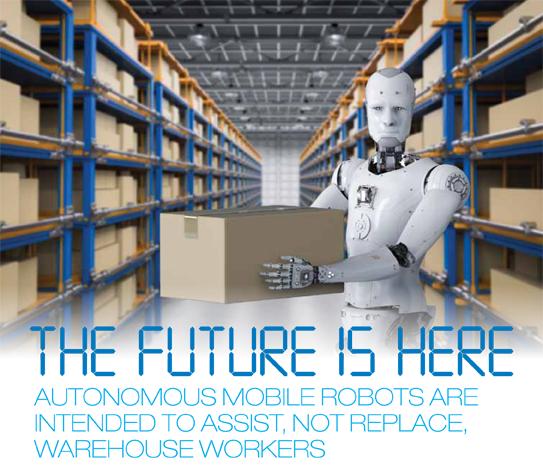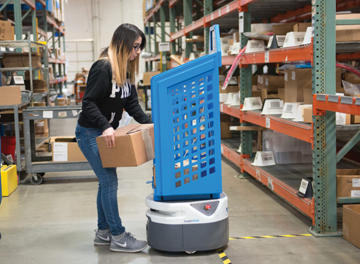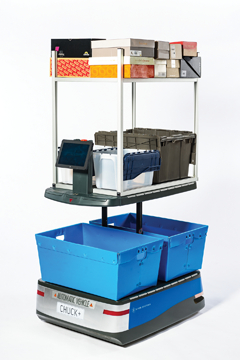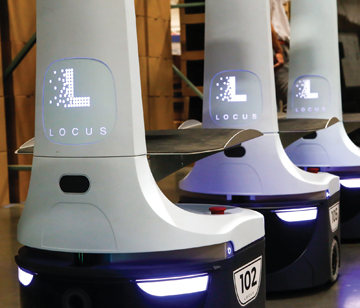The future is here

by Howard Coleman
For many distributors, the old formula of walking around the warehouse from one storage area to the other was acceptable. Following this method, warehouse associates could spend up to 70 percent of their time traveling (walking up to 8 miles per day) and 30 percent of their time actually picking.
Every warehouse or distribution center eventually reaches a pain point. For many, that means a desire to increase throughput without expanding the physical warehouse or substantially increasing labor costs as sales increase. For others it may also mean improving ergonomics. Employees benefit from ergonomically designed picking (reducing reaching and bending), receiving, and put-away operations rather than wandering down and across aisles searching for product or storage bin locations. Add to this the current labor scarcity and the difficulty in retaining warehouse employees, and the consideration of robotics becomes more plausible.
Newer order fulfillment methodologies can assign associates to one (or at least fewer) zones to cut down on foot and equipment traffic. It results in productivity gains (increased time-on-task), but still needs to go further to meet today’s customer service expectations and speed-of-flow warehouse operations productivity goals, with an emphasis on opportunities for future cost avoidance.
Robotics or autonomous mobile robots (AMRs) in warehouses and distribution centers may not be just for the big guys anymore. It could be a solution for you. Picture this: robots doing the travelling and transport, fewer picking carts to push around, and warehouse associates doing less traveling. This is a major development, particularly since robots also can be applied to your receiving and put-away activities.
An operations survey — analyzing your entire inbound and outbound workflow activities, your current KPIs, as well as your technology infrastructure — can determine a potential return on investment and whether a robotics solutions could, in fact, improve your distribution operations environment and your eligibility for a pilot installation. As the comments from robotics providers that follow demonstrate, various acquisition options are available, including robotics-as-a-service (RAS).
 Fetch Robotics
Fetch Robotics
Melonee Wise, CEO
www.fetchrobotics.com
There are two major trends driving robotics adoption. Across the supply chain, e-commerce has placed unprecedented demands on the speed in which to fulfill orders or manufacture products. Many approaches to increasing throughput through automation are quite expensive and take extensive deployment and setup time, not to mention staff training. So, forward-thinking warehouses are turning to robotics to assume some of the simpler tasks and support the existing workforce. Second, the labor market for warehouse and logistics workers is extremely tight. Companies are forced to make do with fewer workers. This is where Fetch’s approach to on-demand automation comes in handy. The solution is not only up and running in a matter of hours, but warehouses and distributors can deploy and re-deploy at will without installing IT systems.
 Fetch’s collaborative robotics solutions for warehouse and logistics fall into two main categories: material handling and inventory tracking. Within these large categories, there are particular autonomous mobile robot (AMR) configurations available to move or track items. The VirtualConveyor AMRs can be deployed and re-deployed in hours and move anything from parts to packages to pallets in warehouses, factories and distribution centers, all while working safely alongside people, forklifts and other material handling equipment. The VirtualConveyor line can transport items with HMIShelf — ideal for packages and has adjustable shelving; with CartConnect — autonomous warehouse carts that can pick up and drop off at any location; and with Freight 500 or Freight 1500 for heavy palletized items. Inventory tracking is performed by the TagSurveyor AMR, which automates inventory cycle counting and reduces inventory loss by collecting, locating and tracking RFID tags on products and bins within warehouses and factories.
Fetch’s collaborative robotics solutions for warehouse and logistics fall into two main categories: material handling and inventory tracking. Within these large categories, there are particular autonomous mobile robot (AMR) configurations available to move or track items. The VirtualConveyor AMRs can be deployed and re-deployed in hours and move anything from parts to packages to pallets in warehouses, factories and distribution centers, all while working safely alongside people, forklifts and other material handling equipment. The VirtualConveyor line can transport items with HMIShelf — ideal for packages and has adjustable shelving; with CartConnect — autonomous warehouse carts that can pick up and drop off at any location; and with Freight 500 or Freight 1500 for heavy palletized items. Inventory tracking is performed by the TagSurveyor AMR, which automates inventory cycle counting and reduces inventory loss by collecting, locating and tracking RFID tags on products and bins within warehouses and factories.
Over the years, traditional industrial distributors have aligned with industrial vendors to provide their customers with a steady flow of products. In many cases, vendors would provide distributors an 8 to 12 week lead time for their products, therefore, leaving the distributor with the burden of keeping a large working inventory. However, as manufacturing continues to evolve, distributors are required to carry larger number of SKUs and deliver those products in a just-in-time manner. Fetch Robotics allows these distributors to quickly move product through their facilities, resulting in faster pack and ship time than ever before.
Two primary challenges face distributors in leveraging robotics technology. One is that there’s not much familiarity with AMRs in general. Many companies purchasing a robot from us have never purchased an AMR before. Our customers and prospects aren’t yet well-versed in how to source, implement and measure ROI. We strive to make this as easy for them as possible, but there’s often some latent apprehension because of the novelty of our offerings. The second challenge is dispelling the myths around robots taking jobs. Fetch’s robots are at the forefront of a shift toward collaborative automation — working with employees rather than taking their jobs.
We’ve helped guide our customers through the education process so that they can best roll out robots in a way that doesn’t instill fear in their workers, but results in workers embracing the robots as the employees are able to focus on tasks that are more interesting and mentally challenging, while the robots take over much of the strenuous physical labor, like carrying and walking.
 6 River Systems
6 River Systems
Fergal Glynn, vice president of marketing
www.6river.com
Fulfillment demand is growing because of the growth of ecommerce, which we read about all the time. Changes in retail are also changing the fulfillment process. As the store footprint is shrinking, there is less backroom storage space, which means companies are shipping out fewer cases and pallets, and instead shipping totes to their stores. Those totes need to be filled in the exact same way as ecommerce orders, with associates picking product and putting it into totes.
There is also a labor shortage. With robots you can make people more productive and you can attract more people into these jobs, as the robot helps reduce the amount of walking and pushing heavy carts around.
Old, heavy, bolted down solutions don’t solve the fulfillment problems for most of the world’s companies. The traditional providers are mainly interested in selling multi-million dollar projects to companies that can afford it like Amazon, UPS and WalMart. The traditional providers don’t seem to be interested in selling to smaller companies that are growing fast and want automation so they can compete against the big players. Fast, flexible and affordable, fulfillment robots can quickly give smaller and medium sized companies access to the automation they need to better serve their customers.
 The 6 River Systems solution is powered by robots (we call them Chucks) and cloud-based software. Chuck communicates with the software to coordinate all the work on your floor. The result? A fleet of Chucks working seamlessly and collaboratively with your associates. We deliver three areas of benefit:
The 6 River Systems solution is powered by robots (we call them Chucks) and cloud-based software. Chuck communicates with the software to coordinate all the work on your floor. The result? A fleet of Chucks working seamlessly and collaboratively with your associates. We deliver three areas of benefit:
1) Eliminate the long walk. By bringing work to the operators in the active area and then delivering fully loaded Chucks to take-off points, we help eliminate all the long walking that your operators did between induct, pick and take-off areas. Depending on your warehouse layout, this can generate a 20 percent to 40 percent benefit on its own.
2) Reduce the in-aisle walk. Our cloud-based services quickly identify the right work to assign to Chuck in real time, while also identifying opportunities for consolidation (batching) and interleaving (pick and replen) on a single Chuck. This decreases the steps your associates complete in between picks, speeding them up. In typical cart picking operations, we see a 30 percent to 40 percent reduction in walking using our work assignment algorithms.
3) Speed up the task. Our patented approach makes all the steps in cart picking faster. By having a fixed scanner, leading associates to the right location and appropriate workflow and eliminating the need to push a cart, Chuck can often reduce task times by 20 percent to 40 percent.
Just like the PC and then SaaS leveled the playing field in computing, what if you could shrink the capabilities of a $100 million warehouse and make them available as on-demand services? What if operators could get the benefits of automation and intelligence without the big, heavy, expensive deployments being pushed down their throats and without having to retrofit or get entirely new infrastructure? What if you could get the productivity gains of Goods To Person at 20 percent of the cost?
At 6 River Systems, we realized you can shrink the capabilities of a big box ASRS or GTP into a molecular level capacity. You get all of the goodness from an automation project and shrink it down into consumable bites. You can order, deploy and consume capacity on a much smaller level as on-demand services.
There are a lot of robot flavors so companies have a lot of choices. The main challenge and my main advice is for companies to think about the types of products and scenarios they are looking to automate, the capacity they require for both on-peak and off-peak, and then choose solutions that solve 100 percent of the problem with an ROI that makes sense for their business.
For example, AGV, which can move things from A to B, has some value but does it solve a big enough problem to make the investment worthwhile?
There is exciting technology around picking eaches but can such an AMR pick all the products you have in your warehouse? Consider the disruption and amount of infrastructure required to deploy a Kiva-like solution or an AS/RS with robots on rails. Operators should have a plan for how they will continue to run their warehouse while this massive work is taking place.
 Locus Robotics
Locus Robotics
Karen Leavitt, chief marketing officer
www.locusrobotics.com
The labor shortage has created a critical issue in warehouses, forcing operators to seek ways to maximize productivity of their existing workforce to meet the continually growing ecommerce and distribution volume. Many are adding automation in the form of “collaborative robotics” to help span the labor gap. Today’s robots are now able to work safely side-by-side with workers with significantly positive results. Autonomous Mobile Robots (AMRs) like Locus’s are specifically designed to be collaborative, delivering dramatically higher worker productivity and volume vs. traditional systems, seamlessly scaling to changing demands, while also improving workplace quality.
 The Locus Robotics solution gives warehouse managers control of their fulfillment and distribution operations through a coordinated system of user-friendly robots coupled with detailed management reporting. The Locus system actively interfaces with the warehouse’s WMS system to maximize the efficiency of each robot, grouping similar orders closer together to minimize unproductive walking and travel times. The solution easily scales to meet changing demands and growth, seamlessly and cost-effectively. The result is significantly lower cycle times and higher units per hour (UPH) volume rates. All of this can be monitored and managed using the LocusView dashboard where managers can see performance in real-time, productivity heat-maps, and more.
The Locus Robotics solution gives warehouse managers control of their fulfillment and distribution operations through a coordinated system of user-friendly robots coupled with detailed management reporting. The Locus system actively interfaces with the warehouse’s WMS system to maximize the efficiency of each robot, grouping similar orders closer together to minimize unproductive walking and travel times. The solution easily scales to meet changing demands and growth, seamlessly and cost-effectively. The result is significantly lower cycle times and higher units per hour (UPH) volume rates. All of this can be monitored and managed using the LocusView dashboard where managers can see performance in real-time, productivity heat-maps, and more.
Distributors are looking for ways to manage growing volumes and increased customer expectations while managing limited labor availability and keeping costs low. The Locus solution gives them a powerful and innovative competitive advantage that’s flexible, scalable and operationally intelligent.
One of the biggest challenges operators face tends to occur during peak season (Black Friday, CyberMonday, etc.) where significant workforce additions are needed to meet demand. Because collaborative robots like Locus are designed to be user-intuitive, there’s minimal training required, allowing even the most inexperienced worker the ability to be highly productive on day one. In addition, since workers don’t need to walk as much as before to be twice as productive, Locus improves the workplace environment, leading to higher levels of retention in an otherwise highly competitive labor market.
 Howard Coleman is principal of MCA Associates. Since 1986, the management consulting firm has worked with wholesale distribution and manufacturing companies that seek and are committed to operational excellence. Contact him at (203) 732-0603 or by email at hcoleman@mcaassociates.com.
Howard Coleman is principal of MCA Associates. Since 1986, the management consulting firm has worked with wholesale distribution and manufacturing companies that seek and are committed to operational excellence. Contact him at (203) 732-0603 or by email at hcoleman@mcaassociates.com.
This article originally appeared in the March/April 2019 issue of Industrial Supply magazine. Copyright 2019, Direct Business Media.












